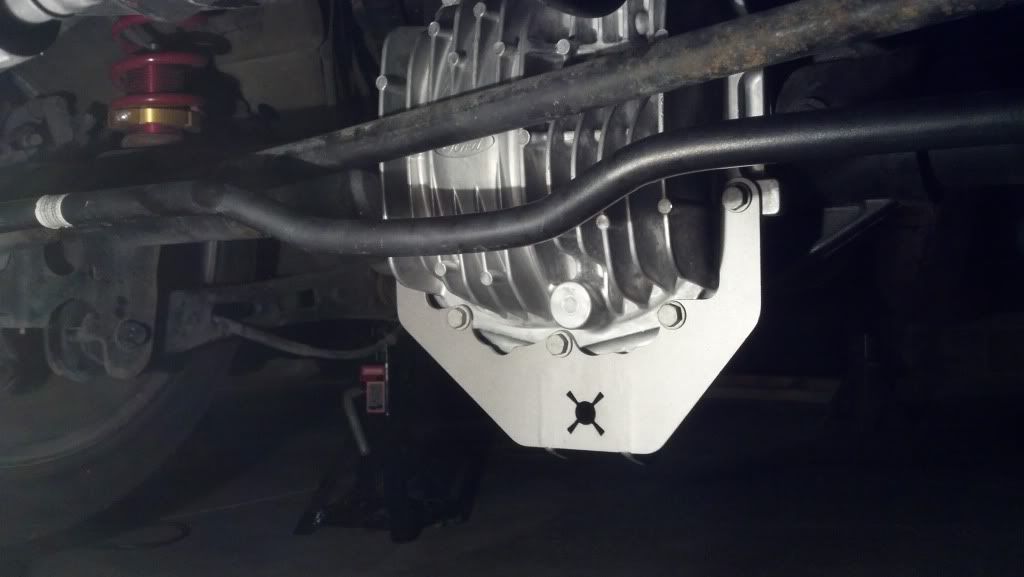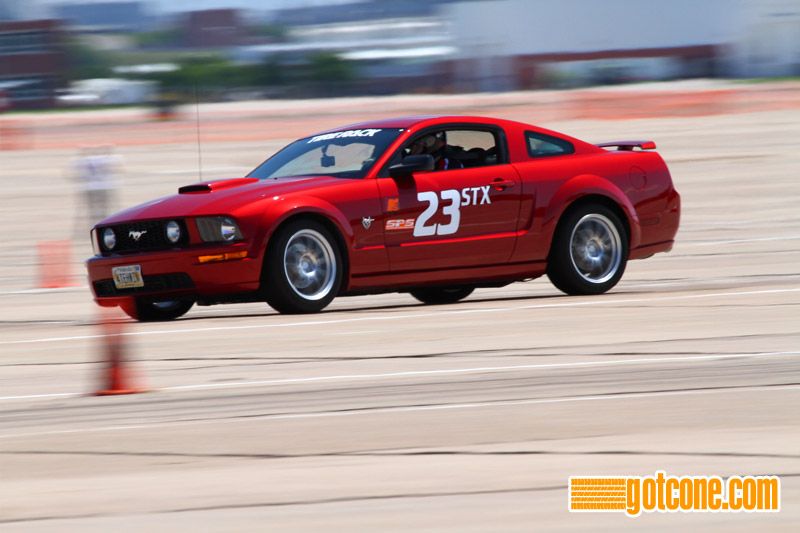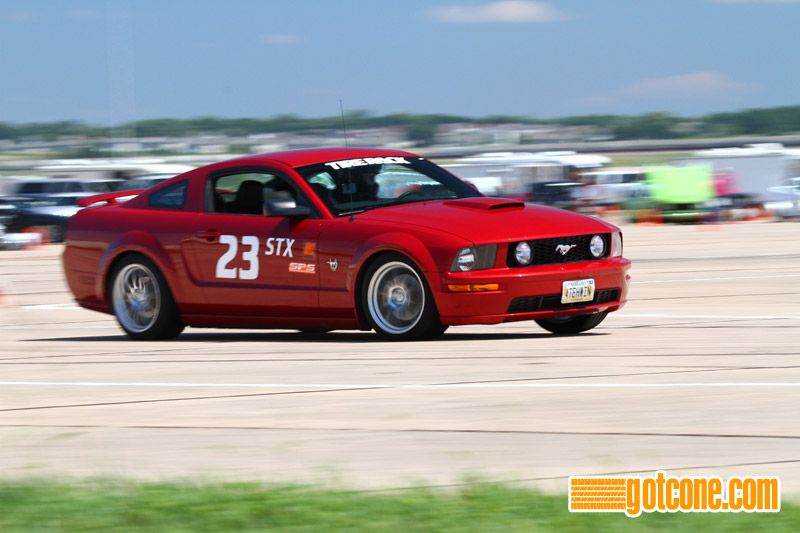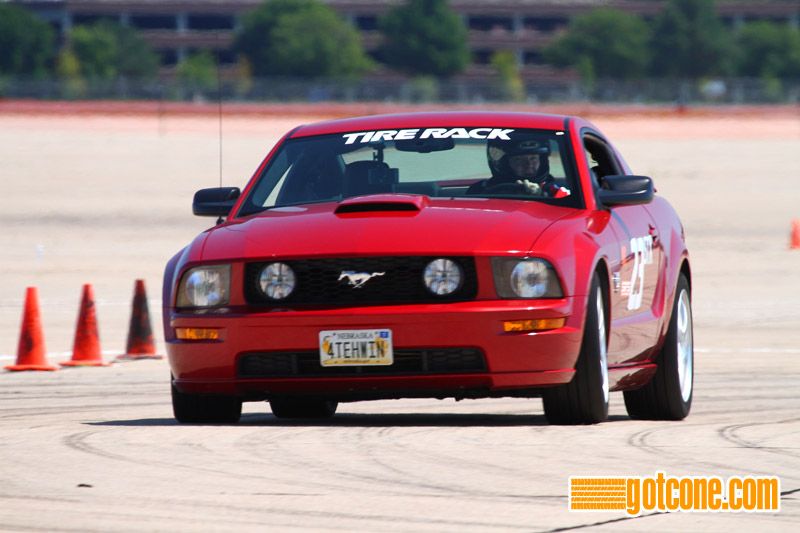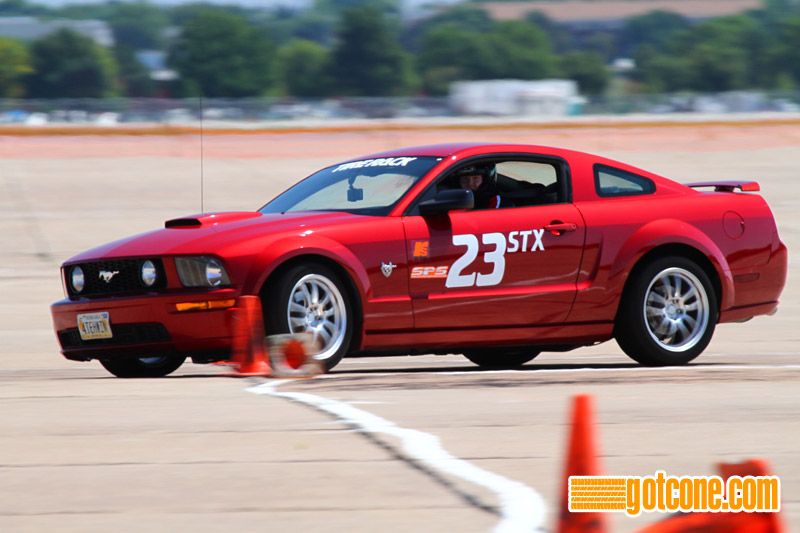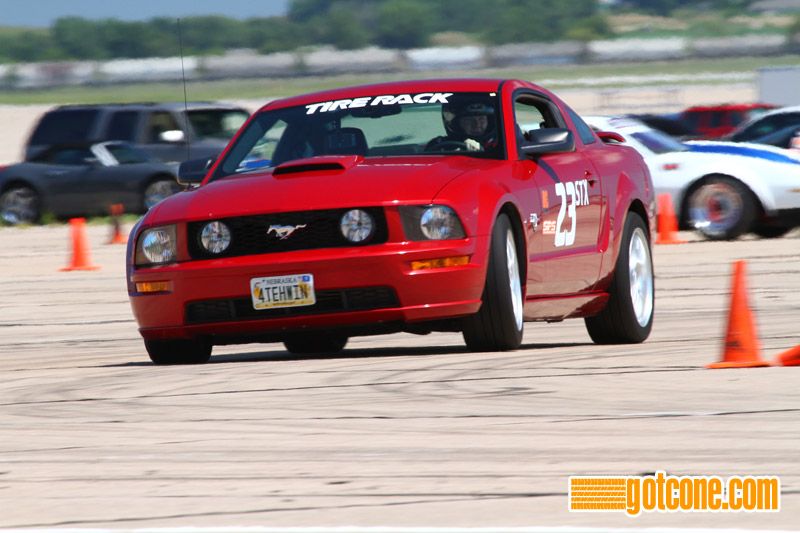Yup, it's that time again! The nice thing is that this is a two day event with TONS of photos and videos to watch!
Project Tilty remains largely unchanged but someone managed to torque my arm into buying a torque arm for this car... well... ok, that someone was ME. Soooooooooo that said, the only things that changed were a freshly rebuilt Traction-Lok with the Carbon Fiber clutch packs, a Ford Racing finned differential cover (!!!!!!!!!!!GASP!!!!!!!!!!!!) and a Cortex Racing Torque arm.
Why the Torque Arm? Weelllllllll..... lets get into some more tech talk. In SCCA's Street Touring and Street Prepared class, there are things live axle cars can't do, like, say, relocation brackets for the rear lower control arms or relocate the chassis side of the UCA. Add in lowering the car to get to a sane ride height for autocross (IE: Not 4x4) and you tend to lose a lot of forward bite. This is a product of the change in antisquat which comes with a number of negatives. One of the things we CAN do is add a torque arm. Basically a torque arm is an arm that is rigidly mounted at the axle end and in a sliding bushing at the chassis end. Basically it's constrained in the vertical direction and lateral direction but free to plunge and extend in the longitudinal direction. The way the torque arm geometry works, the instant center (huge in finding your % antisquat [%AS]) is located in the vertical plane that is perpendicular to the torque arm, at the arm's chassis mounting point. The torque arm does one other fun thing with the force of the pinion gear trying to climb the ring gear in the differential. In the stock 3 link setup, when you step on the gas, the bottom of the differential moves forward because of the insanely soft bushings in the control arms allowing it to tuck under as a reaction to the pinion gear trying to climb the ring gear. With the torque arm, that same action can't occur since the torque arm constrains that reaction. When you step on the gas, that action pushes the chassis end of the torque arm up into the chassis and thanks to Mr. Newton's laws, the opposite has to happen at the axle end, it gets planted into the ground.
To crunch the numbers, the stock Mustang has between 32%-35% antisquat from Ford. Lowering my car the 2.3" in the rear for autocross competition resulted in about 18.60% AS. Adding the torque arm brought it back up to 30.97% which is basically back to stock. The kicker is that it does it without impacting the roll steer characteristics that are associated with relocation brackets. Hopefully this would translate to earlier throttle application and better power down.
Sounds great! What are the disadvantages? There are a few... the most commonly talked about is brake hop. Brake hop in a torque arm is the exact opposite reaction to what happens when you step on the gas. The torque from the brakes (and engine braking) try to rotate the top of the diff forward, but because of the constraints of the torque arm, it tries to lift the axle up. That action can lead to brake hop if the arm is extremely short or you run lots of antisquat through relocation brackets (see drag racing).
The other disadvantage is weight and NVH. While NVH doesn't matter for a race car, it does for people looking at street cars. Terry Fair has yet to find an UCA except stock that doesn't make a lot of noise and the Torque Arm setup I have certainly isn't an option either. I'm not complaining, I knew it would happen! The weight disadvantage isn't huge, but there is one. Basically a torque arm is heavier than the UCA setup. How much so, I forgot to weigh, but it weighs less than the complete Fays2 Watts link (29lbs). If I had to guess, I would say the mount, the diff cover, and the arm probably total up to 30lbs of weight as an extreme estimate.
Of course, because I like to hassle the STAC/SEB, I decided to write a letter asking for an allowance for rear control arm relocation brackets and the ability to replace the rear lower control arms. Here is that letter #12063:
------------------------------------------------------------------------------------------------------------
"Dear STAC/SEB, before I begin the rest of the letter I would like to quote the Street Touring description in the 2013 rule book as I will be refering back to it quite frequently in this letter:
"The Street Touring® category of vehicle modifications is meant to fit between the current Stock and Street Prepared categories. This category provides a natural competition outlet for auto enthusiasts using affordable sports cars and sedans equipped with common suspension and engine modifications compatible with street use."
Next I want to congratulate the STAC and SEB and hopefully the BOD soon on helping destroy a perception issue with pony cars in ST. While none of us are expecting to win in STU, the removal of the 9" wheel width and 265 wide tires has already made a reasonably profound impact on future ST participation. I'm in conversation with about 4 people in the pony car world who are jumping to STU for a Nationals oriented car and about 4 other "serious locals" who are either staying in ST (from STX) or are stopping in STU on the way up to ESP. You've not only reduced that perception but you've reduced the cost barrier associated with ditching the narrow wheels and buying wider ones going to ESP by allowing us to get those wheels and run in STU! Thank you again for that!
While we have that momentum though, there are two modifications in the live axle world that I personally think would go far in attracting and retaining people who drive live axles cars that are extremely common and inexpensive to add. Those modifications are the rear lower control arms and rear lower control arm relocation brackets for the axle side pickup points. Let me explain why I think these modifications deserve to become allowances in ST and SP:
1.) Commonality: If you go to any Mustang or Camaro forum and ask what your first suspension modification should be, near the top of that list is going to be lower control arms and relocation brackets, ESPECIALLY if you decide to lower your car. There are a number of reasons for that ranging from a cure for wheel hop to better forward bite from lowering which I will cover shortly, but the amount of times I see it recommended is very high. It's high enough on the list of "first mods" that on one of the Mustang forums I am a member of, we get a few threads a week asking if they are "truly" necessary and the discussion almost always involves explaining how they aren't truly necessary right away but are strongly recommended later in the cars life.
These modifications are common enough that classing first timers coming from outside the SCCA becomes a massive headache in explaining why these mods that they have land them in C-PREPARED despite being one of the least expensive and most common modifications to a Mustang or Camaro. Of course we could explain how they could also play in Street Modified with a dozen other STI's, Evo's, narrow BMWs and high HP GT-R monsters however the perception there will definitely keep them from coming back.
2.) Price: I'm using one suspension parts supplier (BMR) for this demonstration because they happen to have both third and fourth generation Camaro and S197 chassis lower control arms and relocation brackets that they sell. The cost for the S197 (05-14 years) Mustang lower control arms ranges from $139.95 for a simple poly bushing, boxed DOM, control arms all the way up to $349.95 for CNC machined 6061 T6 aluminum control arms. The first is by far the most commonly sold one. Their S197 relocation brackets cost $149.95 and are 100% bolt on, no welding required. The no welding required includes sub 10 second quarter mile time S197's weighing in at 3500+ (their GT500 ran 9.XXX on these bolted in on drag slicks).
For the fourth generation F-Body Camaros and Trans Ams the control arms range from $149.95 all the way up to $289.95 and the relocation brackets cost $109.95 for a complete bolt in set of brackets.
As you can see, these are not expensive parts in the grand scheme of things and yet they have such a profound impact on live axle handling that they are common first modifications to cars.
3.) Performance: While it is no doubt that the commonality of lower control arms and relocation brackets has to do with the popularity of the pony cars in drag racing, there are some distinct advantages that come from these modifications in the autocross world. First and foremost, axle hop caused by soft factory bushings which are designed to allow the rear axle to articulate without too much bind (ignoring all Fox Body and SN95 Mustangs of course! ;) ) is cured or mitigated with replacing the lower control arms. The upper control arm on S197 cars and the Torque Arm on the third and fourth gen Camaros is already free to be replaced and is the other axle hop mitigating allowance.
The instant center adjustment provided by the relocation brackets allows lowered live axle cars to regain some forward bite caused from the control arm angle change reducing the amount of anti-squat available to the car. While high amounts of antisquat are not necessarily desireable from a handling perspective, retaining SOME antisquat helps these cars put down more power but more importantly it makes the car more FUN to drive because you don't turn your $1500 set of Hoosier A6's or $1300 set of RS3's into expensive smoke any time you look at your gas pedal. On my own car, the factory %AS number is around 34%. Just from lowering my ride height to the still-too-tall-to-be-an-ST-car ride height in the rear of my car I'm down to somewhere between 5%-8%. Under the current rules, due to floor pan constraints there is no way for me to pull that number up by relocating the axle side of the UCA and there is no legal allowance for changing the bracket that holds the UCA in place to lower the axle side (understandable considering that the 05-14 Mustangs are the only cars I know that have such a bracket separate from the Unibody). The only legal modification in which we can do is to exploit the Camaro's Torque Arm allowance and run a torque arm which gets me up to %28 antisquat but with that comes a weight disadvantage and the potential to introduce rear suspension murdering brake hop.
These modifications impact more than just third and fourth generation Camaros and Trans Ams and the 05-14 Mustangs, it also comes with something that makes racing an older Fox Body Mustang (or any fox body for that fact) and SN95 Mustang much more SIMPLE by reducing the cost of developing a weight jacker setup that sits on the rear lower control arm. For these guys, the rear springs are located on the rear lower control arms which in combination with the awful bindfest masqerading as a rear suspension in the car isn't the most ideal setup but under the current rules these guys are required to develope a weight jacker setup that sits on the lower control arms just to corner balance their cars. This requires some custom fabrication that adds to the cost of what is supposed to be your two least expensive class for modified cars. The aftermarket has dozens of weight jacker control arms that have adjustable built in spring perches that would allow for ride height and corner balancing changes to be made to the car without spending the money to develop a complex weight jacker setup to work on the stock control arms. These weight jacker arms are also far more safe than anything that sits on the stock control arm is.
So here is what I propose for the new allowance to say:
14.8.G.X: The lower arms may be removed, replaced, or modified and the pickup points on the rear axle housing may be relocated using bolted on or welded on brackets attached to the factory control arm mounting positions on the axle.
As you can see, the wording is pulled directly from the upper arms allowance (currently 14.8.G.4) with a part added on that should limit these brackets to the same plane (in front or rear view) as the factory mounting points. I can even see adding a provision that says that you can either relocate the upper control arm axle side or the lower control arm axle side but not both. This is not new as a similar statement is made for strut cars and replacing the lower control arm as being allowed so long as it is the only form of camber adjustment on the car.
I would like to thank you again for helping remove the perception barrier of Pony cars in ST with the move to STU and I hope that the move in combination with the above allowances will help the SCCA keep and retain a crowd that isn't interested in building their car as a dedicated SCCA autocross cars but something a little more "universal" that they can take to the drags on Friday nights and then come out to the autocross event on Sunday.
Thanks again,
Chris"
------------------------------------------------------------------------------------------------------------
Ok, enough about the "changes" to the car, on to the actual event after action!
Midwest Divisional Championship Day 1
The Day 1 course was the west course from the 2012 Solo Nationals. This course was ran in reverse during Spring Nationals and we ran it after Nationals last year. It's a fun and fast course with lots of places to lose time if you don't do pay attention!
The class consisted of 4 total cars, myself in the Project Tilty 2009 Mustang GT, Doug Hitchcock's BMW E36, a Cobalt SS and an FRS. All of the cars in the class were prepped pretty well for STX, everyone was on good tires so it was good competition all around.
Course map:
To be honest, I don't remember the exact times but my fastest was like a 64.596 which to be perfectly honest, felt like a rather large disappointment. When we ran this course locally last year, I ran a 65.197... Considering 20mm of tire was added, coilovers with stiffer springs, camber, torque arm and less weight, I was expecting a bit more than basically half a second. Of course, caveat being that it's impossible to compare times from events that far apart, same course or not!
So how did the car drive? Well, it is a learning experience due to the changes but the car felt good while driving. The RS3's didn't like the cooler weather that much but once we got to the third runs they started to work fine. The torque arm itself felt almost exactly the same as the 3 link setup, at least initially. I tried applying power earlier, and it seemed to tolerate it better than the stock setup but it wasn't a huge life changing event to the suspension. More seat time will be good.
My fastest run would leave me in last place going into day 2 which sounds REALLY familiar! My fastest run was also slower than Dave W's RTR 2013 5.0L Mustang which is a lot backwards. Dave is a much better driver though and he was on 10mm wider tires! Excuses, I HAVE THEM!
Midwest Divisional Championship Day 2:
Day 2 would be the east course from the 2012 Solo Nationals but I think they changed the ring of fire some from Nationals and made it more oval than round.
Course Map:
If you were not fortunate enough to run this course at Nationals in 2012, let me tell you, you were missing out! Not only is this course a visually challenging course but it is an absolute HOOT to drive as well! I would say, so far, of any course I have driven, this ranks at the top of my favorite courses. That said, I didn't drive it all that well but I really set out to have fun and relearn the car more than win anything. My fastest time was in the 75 second range. This would put my "total" time at 140.xxxish and last in STX just a second behind the third place guy after two days. Supposedly everyone ran slower times than when they ran it last year for Nationals so who knows if that was a "course change" thing (I swear the ring of fire was more like an oval than a ring) or what it was but it was good for NOT DFL at Nationals Last year, if I was at Nationals last year, this past weekend! ;)
The results haven't been posted yet so I don't have the official times for either day.
What now? Well, every event with serious competition has really, really tweaked the urge to just buy A6's and do the ESP build and deal with the softer spring rates and "weight" disadvantage. I'm "clued in" on buying used A6's for regional events and having a set of nicer ones for the National Tours. I'm going to continue to hold off until things settle down financially. The cost of Nationals, the Midwest Divisional, the Test'n'Tunes and the solo event with the house I just bought, the Torque Arm, the replacement parts for parts I have etc are a bit steep for my taste.
STU sounds like fun but I'm not sure I want to go through the hassle of buying new wheels/tires to run in a class where the car wont be competitive either. I supported the move because I WANT a place to play in ST for Mustangs and this is the safest way to hopefully have the STAC add tire width without the risk of upsetting a class. That said, I have to satisfy my competitive itch TOO and I think the car will do better in ESP now until the cars get some help in ST. The decision is kind of painful to be honest...
That said, what is really next is the Nebraska Region Pre-Nationals Test'n'Tune where stiffer swaybar setting up front, no swaybar out back and a combo of both will be tested. The seat time gained will hopefully prepare me well for Nationals. After that is our regular autocross solo points event in which Dave W has offered to co-drive (how could I refuse? He did raw time me this weekend in a STOCK Mustang on street tires!) of which I have agreed to. After that, Evo Test'n'Tune where hopefully I can get some good seat time as well as some instruction (hopefully?) and then Nationals!
To think the car is "this ready" for Nationals after having just bought a house, moved into said house, added what parts I have to it, and so on is mind boggling. When this is over, there will be a collective sigh of relief! :)
Videos!
Day 1:
Run #1:
Run #2:
Run #3:
Run #4:
Run #5:
Day 2:
Run #1:
Run #2:
Run #3:
Run #4:
Run #5:
